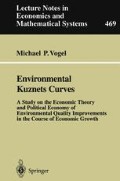Abstract
The past three decades have seen the emergence of a tremendous body of literature on the relationship between growing economic activity and the state of the environment. Without looking at any data, the very flood of papers, articles and books alone already refutes the conjecture that this relationship could be simple, unambiguous, or fully understood. On the contrary, the great bandwidth of results presented suggests a most intricate and diverse link between economic growth and the environment, turning broader generalisations made on empirical grounds into a daring enterprise. In any case, the neo-Malthusian “Garbage in and garbage out”3 view which was widespread in the early 1970s, and still has its advocates, has not been supported by the evidence provided.
Whatever I dig from thee, Earth, may that have quick growth again. O purifer, may we not injure thy vitals or thy heart. Hymn to the Earth, Arthava Veda, 3000 B.C.2
Access this chapter
Tax calculation will be finalised at checkout
Purchases are for personal use only
Preview
Unable to display preview. Download preview PDF.
References
Quoted by King and Schneider (1991), p. 154.
Baumol and Oates (1979), p. 133, quoting a reviewer of “The Limits to Growth” [Meadows et al. (1972)]. The quotation refers to the so-called materials balance argument which holds that economic growth is associated with increasing material input, throughput, output, and ultimately waste or emissions.
The full title of the paper by van Marrewijk et al. (1993) reads: “Is Growth Bad for the Environment? Pollution, Abatement, and Endogenous Growth”.
With their preferred specification of the model, where CO2 is, inter alia, a function of squared per capita income, Holtz-Eakin and Seiden obtain a maximum of CO2 emissions per capita at an income level of about $35,000 (1986 US dollars) per capita. This income lies outside the sampled levels, and it is highly sensitive to the chosen funcional form, so the result should not be relied on. Still more doubtful appears Sengupta’s (1996) finding that CO2 emissions per capita peak at $8740 (1985 US dollars), and subsequently decline when emissions are a function of cubed income, per capita in both cases.
There seems to exist some confusion in terminology. According to Grossman (1995) “dark matter” is the finer and more hazardous form of SPM [p. 27]. Grossman and Krueger (1993) regard dark matter and smoke as the same thing [p. 18]. Beckerman again (1992) treats SPM and smoke as identical [p. 10].
Note the striking difference to Shafik’s (1994a) result mentioned in section 1.2.2 according to which dissolved oxygen is monotonically decreasing in per capita income.
The striving for knowledge without any instrumental function was in fact characteristic of Aristotelian science (“episteme”). Knowledge as a means was referred to as “techne” [Höffe (1993), p. 40]. It was only in the 17th century that Francis Bacon gave science its strong functional orientation [p. 62].
Author information
Authors and Affiliations
Rights and permissions
Copyright information
© 1999 Springer-Verlag Berlin Heidelberg
About this chapter
Cite this chapter
Vogel, M.P. (1999). Introduction. In: Environmental Kuznets Curves. Lecture Notes in Economics and Mathematical Systems, vol 469. Springer, Berlin, Heidelberg. https://doi.org/10.1007/978-3-642-58517-3_1
Download citation
DOI: https://doi.org/10.1007/978-3-642-58517-3_1
Publisher Name: Springer, Berlin, Heidelberg
Print ISBN: 978-3-540-65672-2
Online ISBN: 978-3-642-58517-3
eBook Packages: Springer Book Archive

